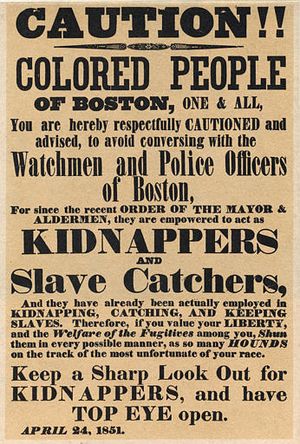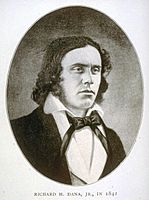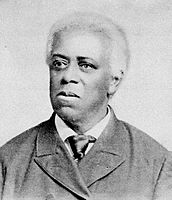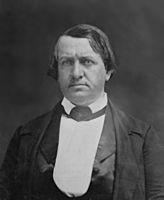Shadrach Minkins facts for kids

Shadrach Minkins (born around 1814 – died December 13, 1875) was an African-American man who escaped slavery in Virginia in 1850. He made his way to Boston, Massachusetts. He was also known by the names Frederick Wilkins and Frederick Jenkins. Shadrach became famous for being rescued from a courtroom in Boston. This happened after he was caught by federal officers under a strict new law called the Fugitive Slave Act of 1850. Brave members of the Boston Vigilance Committee helped free him and hide him. They then helped him travel to Canada using the secret network known as the Underground Railroad. Shadrach Minkins built a new life in Montreal, Canada, where he started a family. Two men who helped him were later put on trial in Boston, but they were found not guilty.
Contents
Shadrach's Early Life
Shadrach Minkins was born into slavery around 1817 in Norfolk, Virginia.
His Escape and Capture
When he was about 33 years old, Shadrach escaped from slavery in 1850. He traveled all the way to Boston, Massachusetts. There, he found work as a waiter. Later that same year, a new law was passed by the government called the Fugitive Slave Act of 1850. This law made it legal for federal agents to capture people who had escaped slavery, even if they were living in free states. It also said that law enforcement in all states had to help return these people to their owners.
On February 15, 1851, federal officers from the United States Marshals Service pretended to be customers at Taft's Cornhill Coffee House, where Shadrach worked. They then arrested him.
The Courtroom Rescue
Shadrach Minkins was taken to a hearing at the Boston federal courthouse. Several lawyers, including Samuel Edmund Sewall, Ellis Gray Loring, Robert Morris, and Richard Henry Dana Jr., quickly offered to help him. They tried to get Shadrach released by asking the Supreme Judicial Court for a special order called a writ of habeas corpus. However, the Chief Justice, Lemuel Shaw, said no.
Edward G. Walker, Robert Morris, and Lewis Hayden worked together to plan Shadrach's rescue. A group of activists, led by Hayden, bravely entered the courtroom. They used force to take Shadrach away from the federal officers. People described this group in different ways, like "African-American activists" or "a group of black Bostonians." One person who saw it said the men had "their faces somewhat disguised." This rescue showed how determined many people were to fight against the Fugitive Slave Act.
After his rescue, Shadrach was hidden in an attic in Beacon Hill. He then escaped Massachusetts with the help of John J. Smith, Lewis Hayden, and others. Nine people were accused of being involved in the rescue, but charges were dropped for some. Robert Morris and Lewis Hayden were put on trial, but they were found not guilty by the jury.
-
Richard Henry Dana Jr., a lawyer who helped many people fighting against being returned to slavery. He never asked for money for this important work.
After the Rescue: Trials and Reactions
The rescue of Shadrach Minkins caused a big stir. Some people called for President Millard Fillmore to use federal soldiers to help officers enforce the Fugitive Slave Law. President Fillmore carefully asked the people of Boston to respect the law and help find Shadrach. He also ordered that those who freed Shadrach be put on trial. John P. Hale was a lawyer who helped defend them. This event was very embarrassing for Secretary of State Daniel Webster, who hoped to become president in 1852 with support from the Southern states.
A New Life in Canada
From Boston, brave activists helped Shadrach Minkins travel to Canada using the secret routes of the Underground Railroad. He settled in Montreal, a city in Canada, specifically in the area known as Old Montreal. There, he started a new life. He first worked as a waiter, then he opened his own restaurants, and finally, he became a barber.
Shadrach got married in 1853 or 1854.
He passed away in Montreal in December 1875. He is buried in an unmarked grave near two of his children in Mount Royal Cemetery.
In 2016, a play called Top Eye Open by Dillon Bustin told the story of Shadrach Minkins.
|








